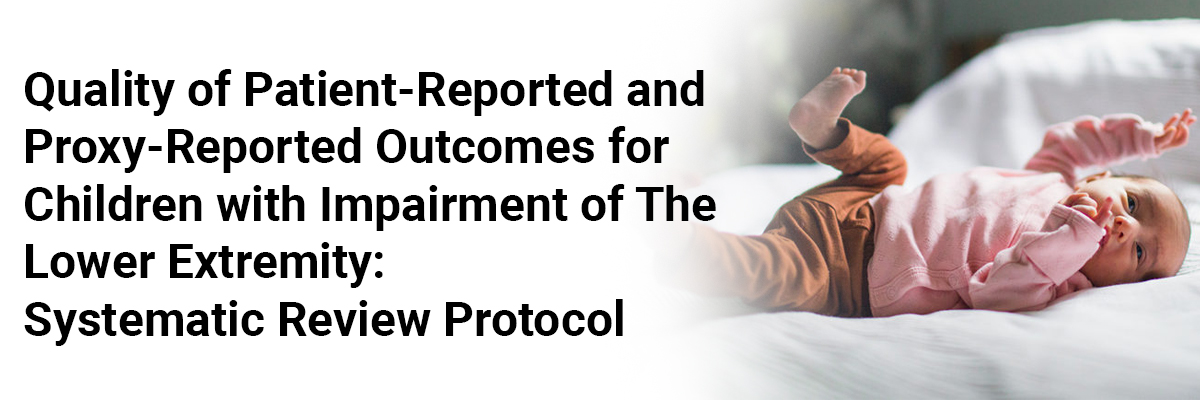
 IJCP Editorial Team
IJCP Editorial Team
Quality of patient-reported and proxy-reported outcomes for children with impairment of the lower extremity: systematic review protocol
Patient-reported outcome measures (PROMs) have become essential in evaluating care and clinical research. Therefore, clinicians and researchers need to use an age-appropriate PROM designed explicitly for the potential diagnosis or injury of the patient; the content validity should fit both the disease and the population. Otherwise, it may result in a PROM being used in either an unvalidated patient population with a validated disease or in a validated patient population with an unvalidated illness.
While developing and using PROMs in pediatric research, clinicians and researchers must consider developmental influences such as age-dependent disease awareness and cognitive– linguistic ability for pediatric qualitative research. Unfortunately, these conditions hinder the proper development of validated and easy-to-use pediatric PROMs, which results in the difficulty of adequate PROM selection in the pediatric orthopedic patient population. Hence, the construction of a comprehensive index of all validated pediatric orthopedic PROMs for children with lower extremity impairments is needed.
As described in a recent publication the protocol development involves information sourcing, determination of inclusion and exclusion criteria, quality appraisal, data extraction, and data synthesis. The first step of the systematic review involves a broad search according to the COSMIN guidelines, emphasizing sensitivity, not specificity, to ensure the identification of all relevant articles. Systematically searching the electronic databases of PubMed and Embase includes a description of the population of interest, PROM developer filter, measurement property filter, and exclusion filter. The exclusion criteria are: any study design in which the patient-reported and/or parent/proxy-reported questionnaire was only used as an outcome measurement instrument (e.g., randomized controlled trials, longitudinal studies, systematic reviews, or meta-analysis); any study in which the questionnaires evaluated the use of prosthetic limbs. All full-text articles are selected for execution of quality appraisal. As per the COSMIN methodology for qualitatively evaluating the modular tool, providing risk-of-bias scores for the psychometric properties uses a four-point rating scale: ‘excellent, ‘adequate,’ ‘doubtful,’ or ‘inadequate.’ During selection, quality appraisal, and data extraction, if the inter-rate agreement falls below 80%, the exact repetition of the entire process continues until>80% agreement is reached.
Visual overview of the standardized parameters
- Characteristics of the included study populations
- Number of patients
- Age (mean and dispersion) in years
- Gender (% of females)
- Disease characteristics
- Disease, duration in years, severity
- Instrument administration
- Setting, country, language
- Response rate
- Characteristics of the included PROMs
- Testable construct
- Target population
- Mode of administration
- Recall period
- Subscales (number of items in the questionnaire)
- Response options
- Range of scores/scoring
- Original language
- Available translations
- Evidence of the psychometric measurement properties of the studied PROMs
Using questionnaires/PROMs in orthopedic medical care will become the trend in daily practice and research. In addition, it will encourage future research to focus more on proper development and validation studies on PROMs.
Source- Saris T, Kalle R, Sierevelt I, et al. Quality of patient-reported and proxy-reported outcomes for children with impairment of the lower extremity: systematic review protocol BMJ Paediatrics Open 2022;6:e001486. doi: 10.1136/bmjpo-2022-001486.

IJCP Editorial Team
Comprising seasoned professionals and experts from the medical field, the IJCP editorial team is dedicated to delivering timely and accurate content and thriving to provide attention-grabbing information for the readers. What sets them apart are their diverse expertise, spanning academia, research, and clinical practice, and their dedication to upholding the highest standards of quality and integrity. With a wealth of experience and a commitment to excellence, the IJCP editorial team strives to provide valuable perspectives, the latest trends, and in-depth analyses across various medical domains, all in a way that keeps you interested and engaged.




















Please login to comment on this article